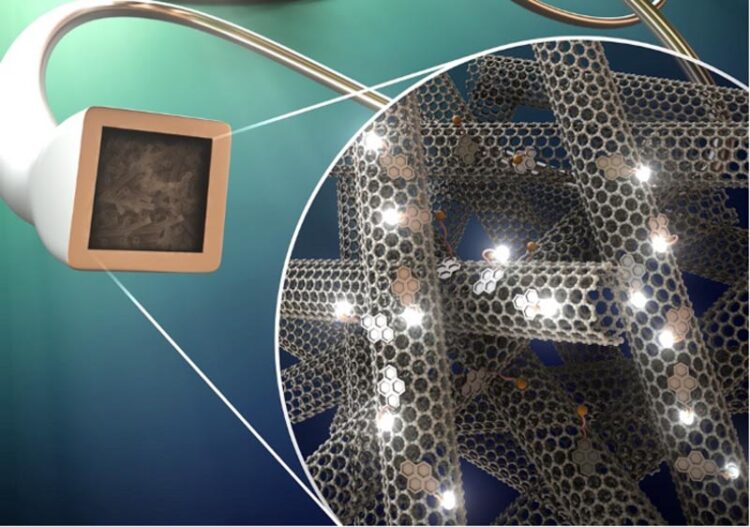Reading chemicals inside the brain

The aptamer-coupled microelectrode fiber sensors (apta-μFS) for neurochemical sensing.
Credit: T.Saizaki et al.
… with an aptamer/microelectronic fiber combination.
A research group has developed a neural device that detects specific neurotransmitters in the brain with high sensitivity and selectivity by combining multifunctional fibers and DNA molecular probes.
Details of their research were published in the journal Analytical Chemistry on April 24, 2023.
It is estimated that over a billion people suffer from brain disorders worldwide. Current therapeutic techniques use electrical modalities to establish an interface with the brain. This typically involves electrodes being used to read electrical potential or deliver electrical currents to specific tissues of organs in the body.
However, cells inside the brain communicate with each other via chemical signals, and thus researchers have been looking for ways to measure and manipulate both the electrical and chemical signals.
One such breakthrough in this regard has been microscopic, thermally-drawn microelectronic fiber-based neural probes that can act as an interface with the brain across electrical, chemical, optical, and mechanical modalities. Still, the capabilities of this technology for studying intrinsic in-brain chemistry have yet to be explored, and few attempts have studied how it could be integrated with multi-modal and multi-level brain studies.
“We expanded the capabilities of the fibers to include neurochemical sensing,” says Dr. Yuanyuan Guo, associate professor at Tohoku University’s Frontier Research Institute for Interdisciplinary Sciences (FRIS), and leader of the research group. “We coupled aptamers, a new type of biosensor comprising a single strand of synthetic DNA with customizable sequences, on the microelectronic fibers. These defined aptamers sense neurochemicals with high sensitivity and high selectivity.”
Aptamers can be thought of as keys that specifically unlock the locks of certain target molecules. Like a key fits into a specific lock and opens it, an aptamer can bind to a specific molecule and interact with it in a selective manner.
In the study, the defined aptamer sequences bound to specific molecules with a high affinity, inducing a reversible three-dimensional conformational change from a relatively simple chain structure into a complex structure wrapping around targets. Aptamers were tagged with ferrocene as an electrochemical readout for target molecule and aptamer binding.
The research group focused on dopamine due to its physiological significance in mediating learning behavior and motivation. But Guo points out that this sensing mechanism is applicable to other molecules regardless of their charge or electrochemical profile. “Our discovery provides a universal method for fiber surface modification, to monitor wide-range molecules of interest.”
Ultimately, the breakthrough will hopefully enable the development of new brain research and methods for the prevention and treatment of diseases of the brain and organs that have not been elucidated to date.
Journal: Analytical Chemistry
DOI: 10.1021/acs.analchem.2c05046
Article Title: The development of aptamer-coupled microelectrode fiber sensors (apta-μFS) for highly selective neurochemical sensing
Article Publication Date: 24-Apr-2023
Media Contact
Public Relations
Tohoku University
public_relations@grp.tohoku.ac.jp
All latest news from the category: Life Sciences and Chemistry
Articles and reports from the Life Sciences and chemistry area deal with applied and basic research into modern biology, chemistry and human medicine.
Valuable information can be found on a range of life sciences fields including bacteriology, biochemistry, bionics, bioinformatics, biophysics, biotechnology, genetics, geobotany, human biology, marine biology, microbiology, molecular biology, cellular biology, zoology, bioinorganic chemistry, microchemistry and environmental chemistry.
Newest articles

NASA: Mystery of life’s handedness deepens
The mystery of why life uses molecules with specific orientations has deepened with a NASA-funded discovery that RNA — a key molecule thought to have potentially held the instructions for…

What are the effects of historic lithium mining on water quality?
Study reveals low levels of common contaminants but high levels of other elements in waters associated with an abandoned lithium mine. Lithium ore and mining waste from a historic lithium…

Quantum-inspired design boosts efficiency of heat-to-electricity conversion
Rice engineers take unconventional route to improving thermophotovoltaic systems. Researchers at Rice University have found a new way to improve a key element of thermophotovoltaic (TPV) systems, which convert heat…



